When compared to other coat color variations, tri-color Pitbulls stand out as gorgeously unique. This is because they are very uncommon among the Pitbull breed and they possess color patterns that no one expected to see in a Pit.
If you are doing your research because you wanted to get your first tri-color Pitbull, look no further. This article will serve as your comprehensive guide in caring for tri-color Pitbulls as well as in becoming an expert on their unique features and temperament.
Important note: The “Pitbull breed” is more of an umbrella term for various breeds of Bullies including American Bullies, American Pitbull Terrier, American Staffordshire Terrier, and Staffordshire Bull Terrier. Canine evolution is tight-knit and some argue that American Bulldogs and French Bulldogs belong to the same family.
The name tri-color Pitbull refers to a variety of breeds that don a remarkably new color pattern that includes three stunning hues. Usually, they have a base color that can range from black to lilac and two other shades that are oftentimes tan and white.
Because of the hype that this dog is getting, breeders found it very exciting to create more color combinations, making tri-color Pitbulls rare and their genetics a little more complex than the regular dog.
But you don’t have to worry about their health because responsible dog breeders are also careful when it comes to breeding these bullies to keep them in top shape.
Watch the video below to see how a tri-color Pit looks like:Our 170lb Black Tri-Colour Bully Is The Worlds Biggest | BIG DOGZ
The most common color combination of tri-color Pitbulls would remind anyone of the sweet and playful Beagle with a patched black, brown, and white coat color combination.
All tri-color Pitbulls will have some white fur on their body and the base colors can vary. There are not many tri-colored Pitbulls that exist but here are some combinations of the tricolor:
This rare tri-color Pitbull has an almost solid lilac coat with smaller patches of tan and white, mostly around her neck. The area around her paws, snout, ears, and hind legs have very fine, tan fur.
This little dog also has an almost solid black coat with two more colors appearing on the area around her neck and on all four legs. Her snout has a small strip of white as well as spots of white on her paws. The leg areas are covered in tan fur.
This tri Pitbull’s shiny brown coat also has different shades in this photo which makes him look like he has more than three colors. There are some tan patches on his facial area, a few white spots underneath, and the rest of the tan is on her front and hind legs.
The color combinations resemble that of a typical Beagle but Pitbulls really don them uniquely in terms of the shade of colors and the varying patterns.
This merle tri-color Pitbull is a combination of blue merle, fawn, and white. The pattern is dramatically painted that when the pup is sitting, you can witness the three colors bursting in his coat.
This blue tri-color Pitbull has a well-balanced color distribution. There is a blue, tan, and white mask covering the paws and the majority of the upper body. The rest of the body is covered in blue fur.
This puppy is a purple tri-color American Bully with a perfect distribution of colors. Tan can be seen on the legs as well as a little bit on the snout and white on the neck area. The rest of the coat is purple.
What Is A Tri Color Pitbull?
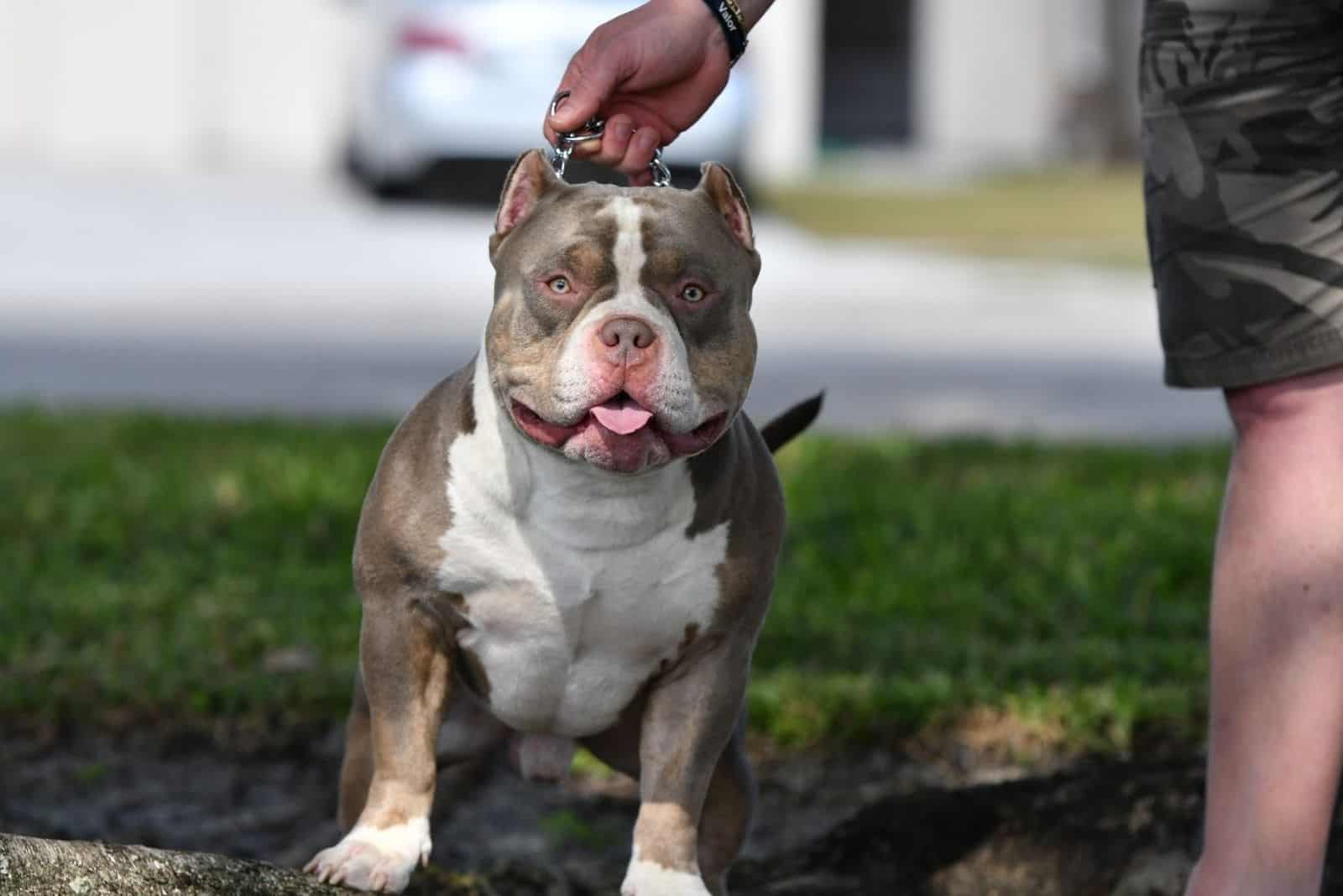
Tri color Pitbulls are Pitties with a unique color pattern that is fairly new in this breed. As their name suggests, they have three different hues on their medium to low-shedding coat.
Typically, they have one basic color that ranges anywhere between black and blue or lilac and two other shades that are usually white and tan.
As these dogs have become more and more popular in the past few years, breeders are creating as many color combinations as they can, especially as there are plenty of possibilities when you have three colors to work with.
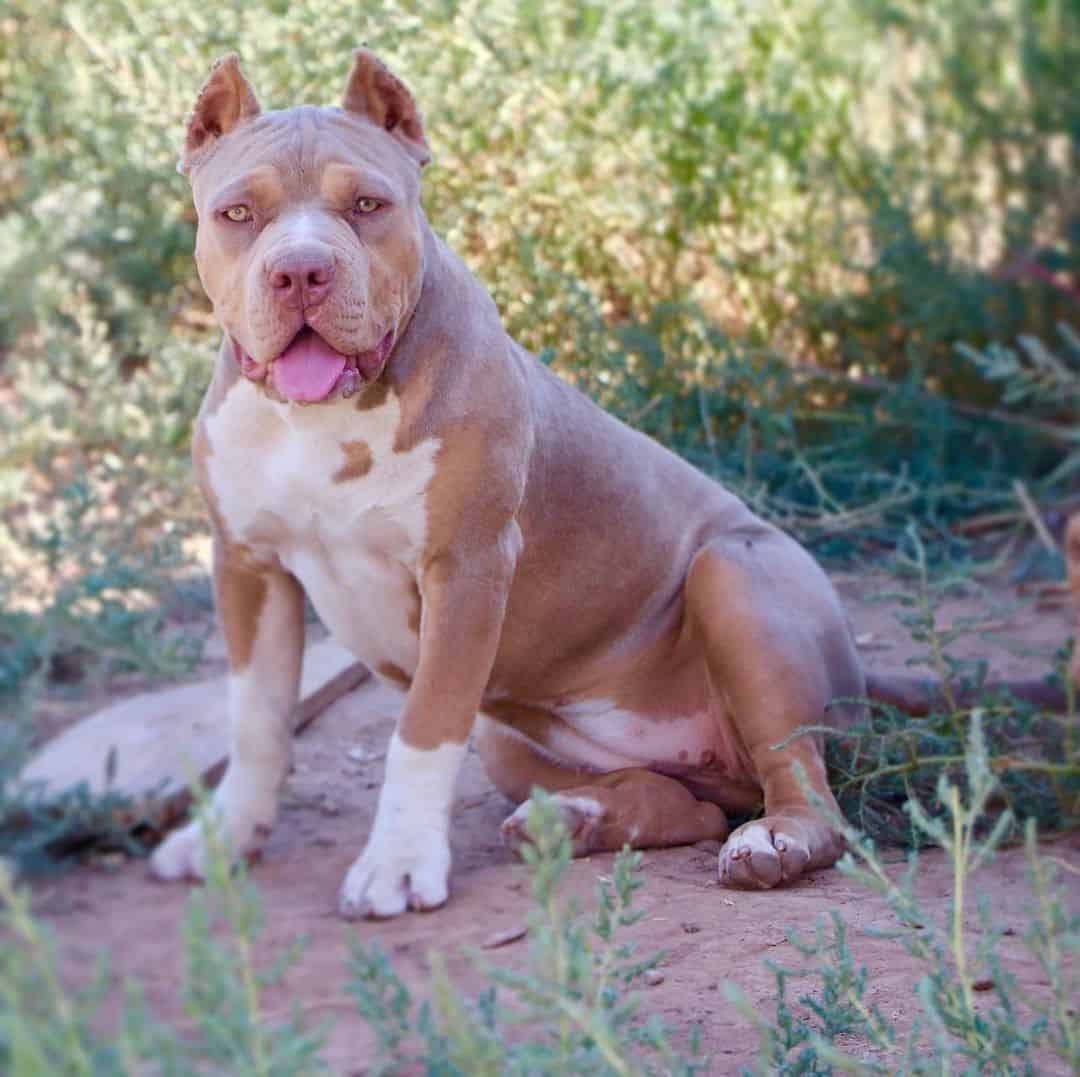
Photo from @dukecitypitbulls
Despite their growing popularity, tri color Pitbulls are somewhat rare. There are a few reasons behind this.
First off, most breeders avoid breeding tricolored Pits for several generations at a time. This is because these pups can be mistaken for mixed-breed dogs, and this is something breeders don’t want for their tri color Pitbull puppies.
This is especially true of Bully breeders, as these dogs are more valued for their pedigree than for the coat color they have – but more on this type of Pitbull later on.
Secondly, the genetics behind the tri color Pitbulls are somewhat complicated.
The color and pattern of a Pitbull’s coat are determined by Agouti genes. It depends on the variations of the Agouti locus alleles. The alleles that determine the main coat color are:
A allele – it causes the dominant black color that might be more or less diluted if the dilution gene is present. If an A allele is present, you’ll most likely get a black, blue, or chocolate puppy.
Ay allele – it produces the dominant yellow coat color. Typically, this allele is responsible for red and buckskin tri color Pitbulls.
At allele – this allele produces solid-colored tan point Pitbulls. This is a recessive gene, meaning it won’t express itself on the coat if one of the other two alleles is present.
Also, since recessive genes can stay hidden for generations, this means it might be difficult to know whether or not a pup is a carrier of the At allele.
These alleles have to be carefully matched to get a desired tri color puppy – not to mention that there is no guarantee that the same combination will produce two identically colored puppies!
Here are a few examples:
If your dog is tan and black, he has inherited an At allele from both of his parents. This is because the tan point gene is recessive, and there is no other way to get it.
A buckskinned or red dog inherited an At allele from one of its parents but the Ay allele from the other one.
On the other hand, a solid black color is caused by the mix of the A allele and At allele – but this is the same combination that makes solid blue or brown dogs.
As we’ve mentioned before, tri color Pitbulls come in a wide variety of colors. The colors and patterns are usually named after the base coat color – or rather, after the dominant color on their body.
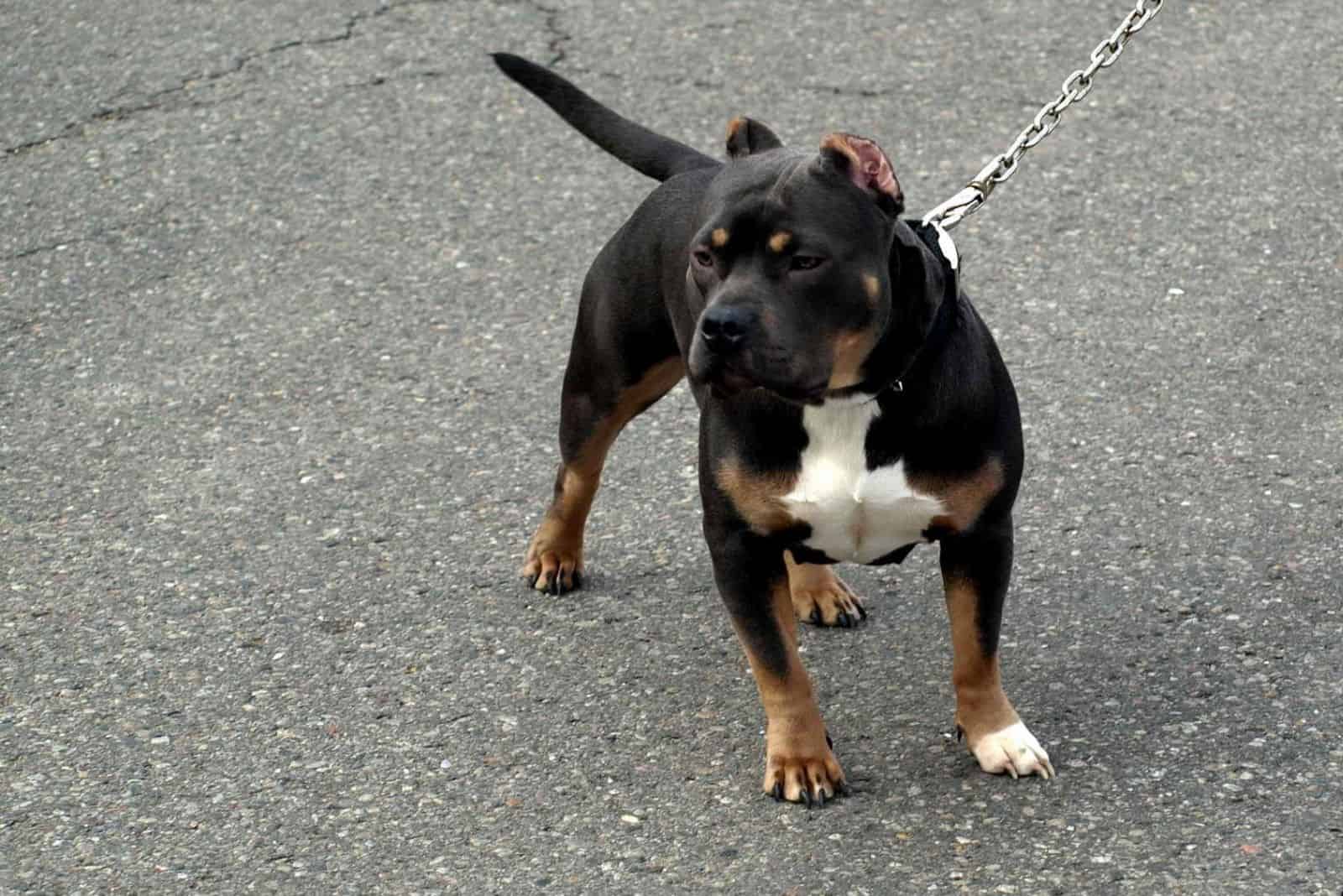
This is probably the most common main color in tri color Pitbulls. These pups have an almost solid black coat with two more colors (most likely white and tan) around their necks and on their legs.
Tan markings are usually above the dog’s eyes and nose, on their legs and chest, while the stomach and paws are typically white.
Chocolate tri color Pitbulls are quite common within the American Bully bloodlines. This is because many Bullies come in this base coat.
This is considered the ‘dullest’ coat combination of all the tri-colored dogs, as a Pitbull with this pattern simply looks as if it has three shades of the same color – the darkest one being chocolate and the lightest being white.
Still, these dogs are some of the more popular when it comes to the Pitbull breed.
Brindle dogs have the so-called ‘tiger stripes’ on their body. While typical brindle Pitbulls have most of their coat in brindle with a few white markings, tri color brindle Pitbulls include patches on the coat where the brindle isn’t present.
Depending on the main coat color, you can have blue brindle tri color Pitbulls, red brindle color Pitbulls, liver brindle color Pitbulls, etc.
These brindle markings aren’t always discernible, as some patterns make them more noticeable than others. However, if you look closely, you can always see stripes on some parts of these dogs’ bodies.
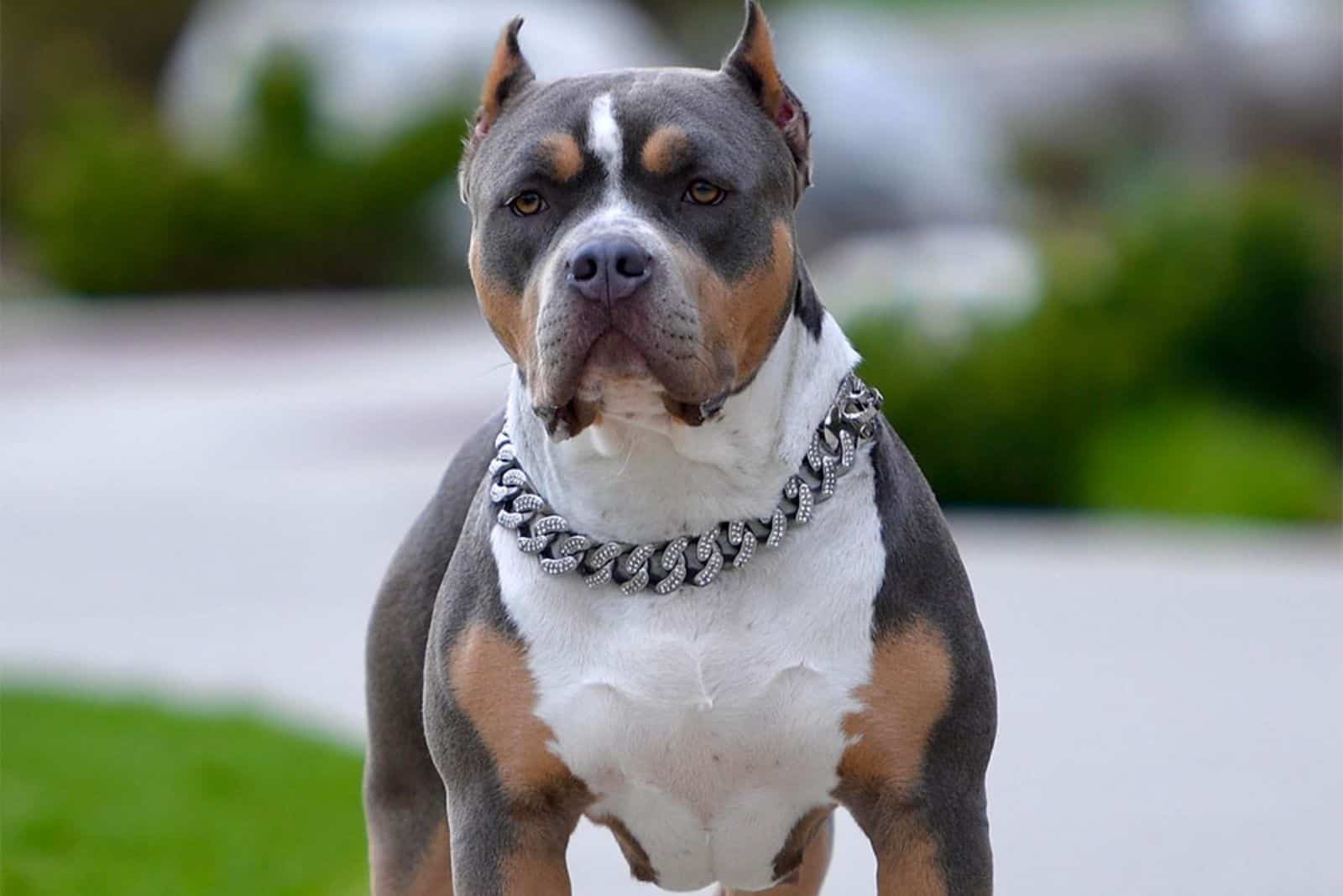
Blue tri color Pitbulls are somewhat common compared to other, more exotic colored coats.
Like most other tri-colored Pits, they mostly have tan and white markings on their heads, stomachs, and legs. Their base coat can vary anywhere between dark blue (that resembles black) and bright silver.
A fun fact is that these dogs will always be blue nose Pitbulls since the blue coat color always comes with a blue nose. If the dog’s nose is black or brown, the canine in question is a tan tri color Pitbull.
A purple tri color Pitbull has a gorgeous combination of colors on its coat. These pups have a purple (warm shade of blue) coat with tan and white markings on some parts of their bodies.
Purple Pitbulls have a coat that seems to be a somewhat warmer shade of blue. These pups’ markings are usually lighter than most other combinations, sometimes even in a champagne or warm grey color. The third color will almost always be white.
Unlike with blue tri color Pitbulls, these pups don’t have as visible tan markings, so they might appear to be only purple and white until you look at them closely.
Merle Pitbulls usually have more than three colors on their coats – but many people still put them under the tri color umbrella. In fact, most merle Pits have one base coat color (making them blue merles, red merles, fawn merles, and so on), that same color but diluted, and tan and white markings.
These markings are usually located on the same spot as with most tri color puppies – on their snouts, above their eyes, on their cheeks, chests, stomachs, and legs. These dogs also mostly have blue eyes or heterochromia.
It is important to note that merle is a very dangerous color that can lead to many health problems in all dog breeds, and not just Pitbulls. This is why most reputable dog breeders stay away from it.
This is because the merle pattern is the result of dilution genes that dilute the dog’s entire body, not just its coat color. This includes their skin, nerves, and heart. In fact, many homozygous merles (dogs that carry two merle genes) are entirely deaf or blind – or even both.
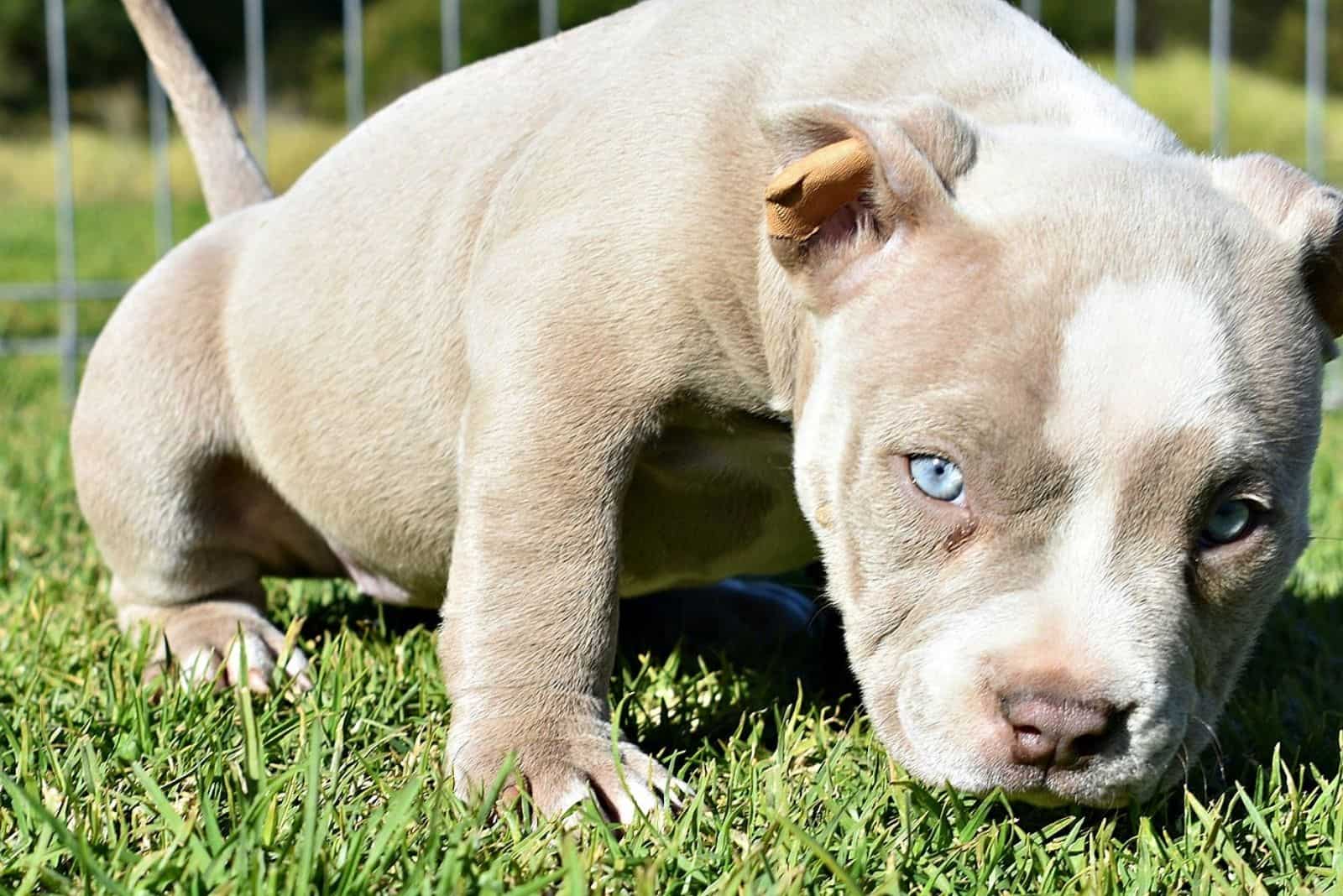
This is one of the rarest Pitbull colors, making this a unique tri color combination.
These dogs usually don’t have tan markings that are typical for most tri color Pitbulls. Instead, they have white markings and silvery-blue ones, making them a remarkably unusual sight.
Even if they do have tan markings, they are usually lighter in color, giving these dogs an overall gentle appearance.
Similar to fawn tri color Pitbulls, these dogs also have very gentle colorings and markings.
While the base of their coat is light beige or, rather, champagne in color, they sport white and tan markings. The tan markings don’t necessarily have to be lighter than the champagne, but they’ll always be warmer.
This is a rare color in Pitbulls, no matter the pattern.
Lilac tri color Pitbulls usually have most of their body covered in this color. However, they still have tiny tan and white patches, usually around the neck, snout, ears, hind legs, and paws, that indeed make them tri-colored.
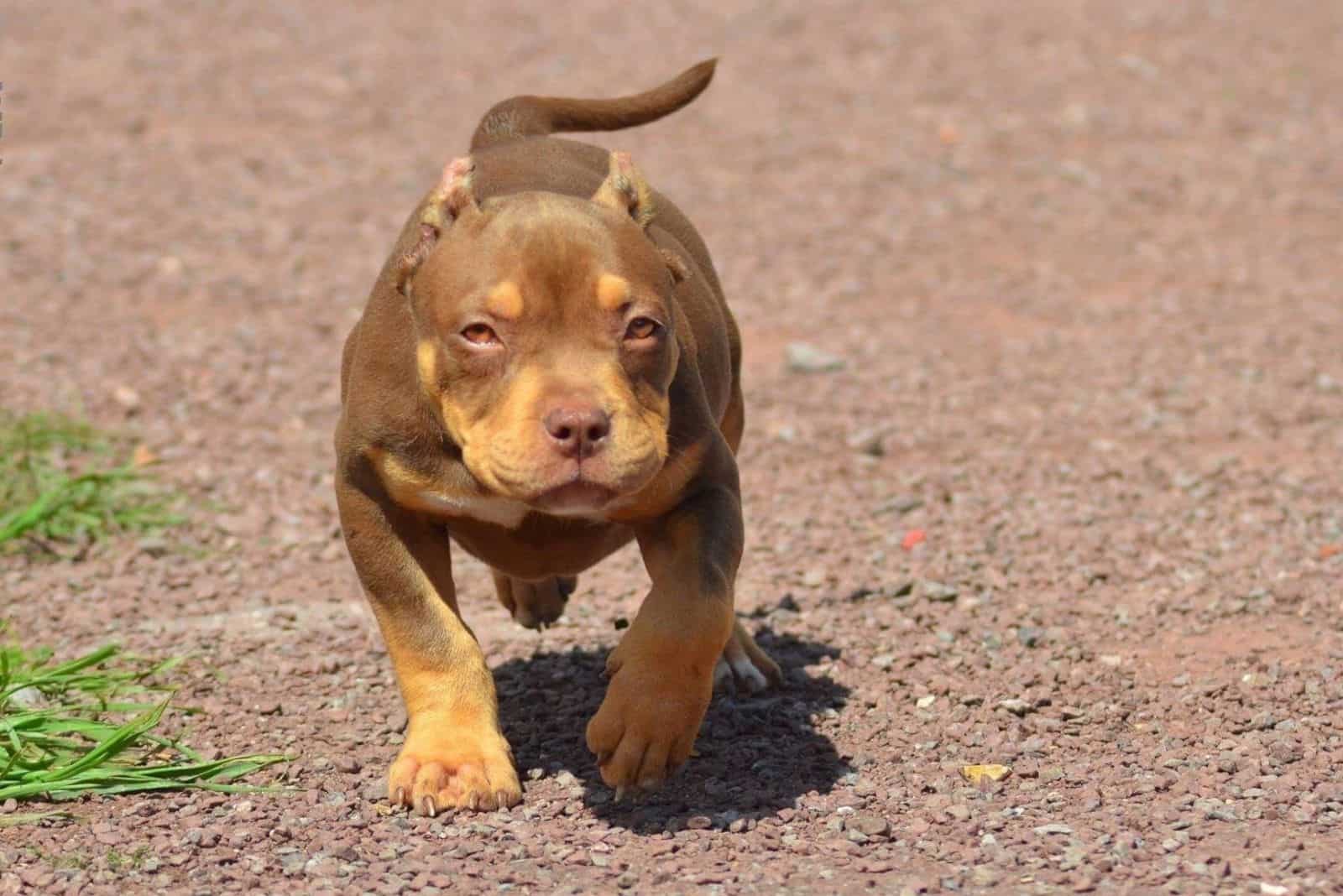
These dogs are very similar to the chocolate and purple tri color Pits, except their base coat color is in a lighter, reddish shade.
They usually have more white than tan markings, but exceptions do exist. The tan markings are typically located on their cheeks, above their eyes, and on their chests and legs.
White tri color Pitbulls can have any two of the other possible Pitbull colors on them – however, most of their coat will stay white.
There is some controversy about white tri color Pitbulls and other Pitbulls that have white as their primary coat color. This is because the lack of pigment that causes the white color is also connected with some health concerns such as blindness and deafness.
Also, white tri color Pitbulls can never be albinos, as dogs suffering from albinism have a pure white coat.
There is a difference between a white tri color Pitbull and a merle Pitbull. While white tri color Pitbulls have large patches of different colors, merles usually look splattered or spotty, and the colors aren’t sharply defined, as is the case with white tri color Pitbulls.
Similar to white tri color Pitbulls, these pups can be of any color; however, the primary color on their body will be tan. This means they’ll have white or cream markings and markings of a darker color – usually brown, but blue and black are also very common.
These dogs have a blueish-gray coat that looks almost silver. They also have white and cream markings (rarely tan, but they are possible).
This is one of the rarest combinations in tri color Pitbulls.
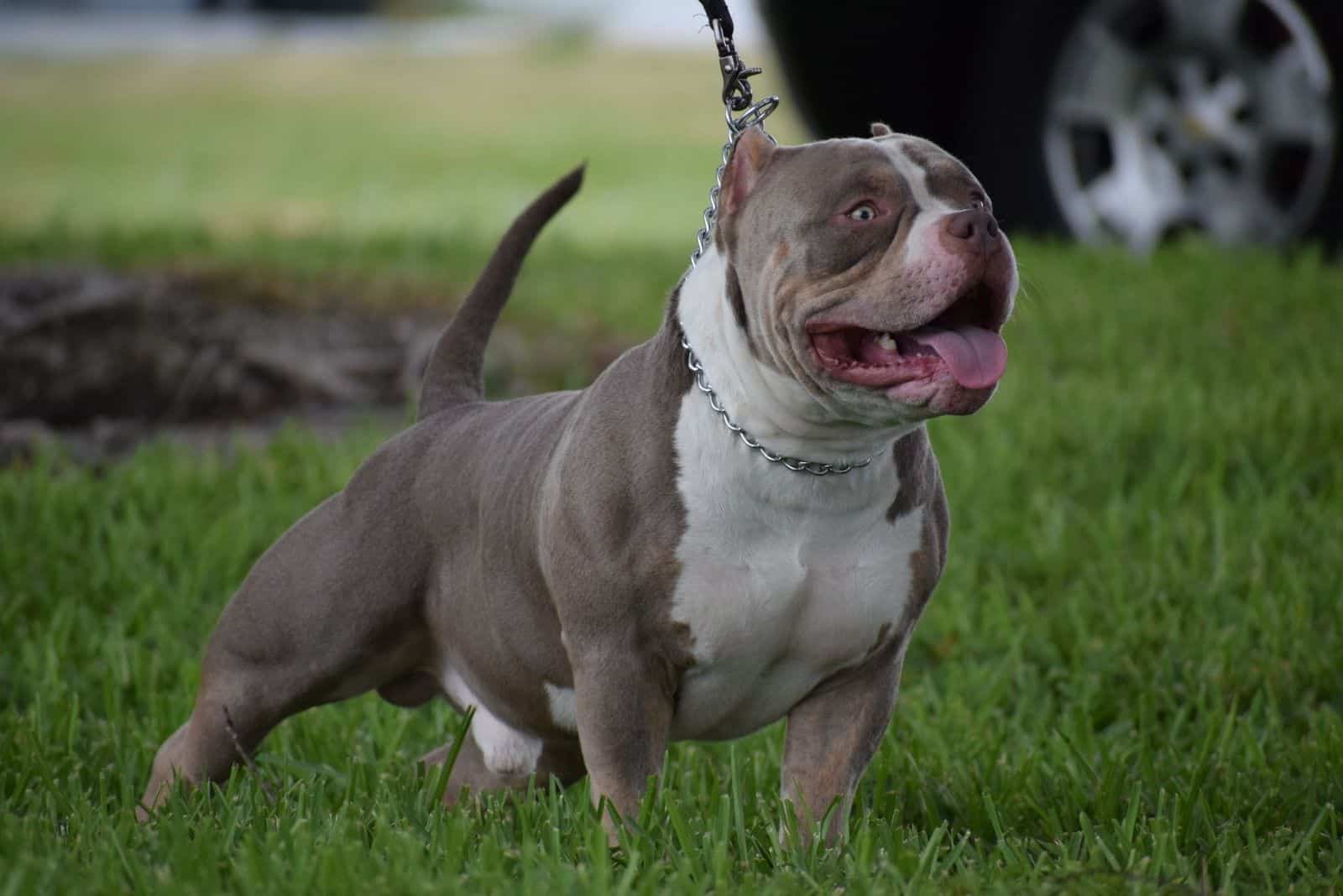
American Bullies are a group of so-called XXL Pitbull bloodlines recognized by the American Bully Kennel Club (ABKC) that produce dogs with a unique appearance. These dogs can come in many colors – but tri color isn’t the most popular.
These dogs are usually called tri color Bullies, and they can come in any pattern as regular Pitbulls can. Whether we’re talking about Texas Size Bullies or Pocket Bullies, all Pitbull colors are possible.
However, American Bully breeders aren’t partial to breeding dogs in this pattern. Bully Pitbulls tend to look like crossbreeds on their own, and the tri color pattern only worsens this impression.
Not just that, but since breeding of tri color Bullies is so rare, this color pattern will seldom appear in these dogs even when breeders attempt to get it.
The rarity of the color might also influence the price of a tri color American Bully breed – while these pups might be more expensive in some places, other breeders will sell them for cheap just to get rid of them.
Where did tri color pit bulls come from?
The Creation of the Tri Pitbull is from selective breeding and all breeders say that they have never used another breed to get that color but we know other breeds have been mixed to create Tri Colored dogs because this whole style of dog was created on the result of combing breeds.
How Much Does a Tri-Color Pitbull Cost? Are They More Expensive Than Other Varieties?
Tri-color Pitbulls do not cost more compared with other varieties. Most tri-color Pitbull puppies are priced at $750 on average, with no difference regarding coat colors and patterns.
Some breeders may sell them at a higher price but the pricing is affected by other factors such as the puppies’ generation, papers, and shots.
FAQ
What makes a dog a tri?
What is the rarest color of Pitbull?